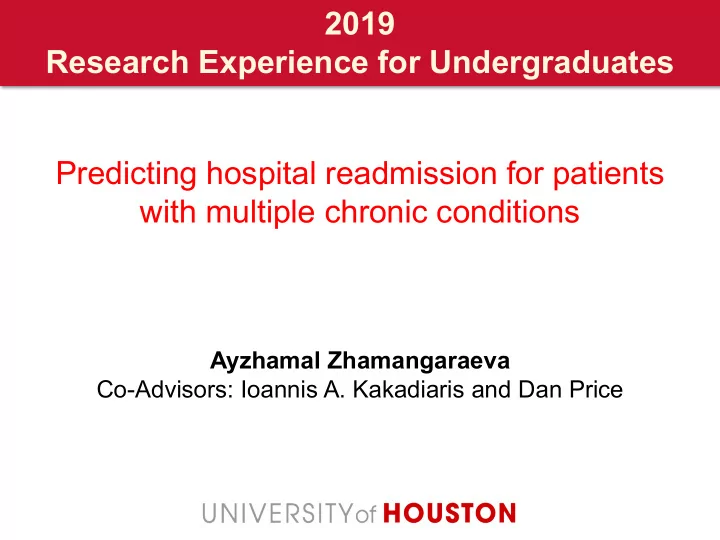

2019 Research Experience for Undergraduates Predicting hospital readmission for patients with multiple chronic conditions Ayzhamal Zhamangaraeva Co-Advisors: Ioannis A. Kakadiaris and Dan Price
Motivation Decreasing readmission rates will • Decrease health care costs • Help hospitals to avoid Medicare readmission penalties (since October 1, 2012) • Improve patient care Statistics • In 2015, 2,592 US hospitals out of 5,627 registered hospitals received penalties from the CMS (losing a combined $420 million) • Historically, nearly 20% of all Medicare discharges had a readmission within 30 days.
Goal To develop, implement and evaluate an algorithm to predict hospital readmission for patients with multiple chronic conditions
Objectives 1. Prepare the data to which the analysis will be based 2. Develop a prediction model 3. Evaluate the prediction model
Expected Impact • To adjust the care of an individual with a high risk of readmission o Reduce costs o Improve quality of life
Deliverables 1. Dataset with computed features 2. Source code for models 3. Literature review XLS and report 4. Final report
Original Humana dataset Includes 4 tables: Med (57G) 716,464,506 rows x 35 columns Lab (69G) x 13 columns Rx (120G) 662,379,439 rows x 22 columns Pat (1.3G) 12,913,657 rows x 42 columns Deidentified records of three years 01/2013-12/2015 Challenge: 2 files out of 4 are corrupted.
Objective 1: Tasks 1. Define my cohort 2. Write R script to filter and analyze cohort 3. Compare positives and negatives 4. Derive new features from the comparison 5. Write R script to compute new features 6. Partition to training, testing, and validation datasets
Objective 1: Remaining Work 1. Define my cohort 2. Write R script to filter and analyze cohort 3. Compare positives and negatives 4. Derive new features from the comparison 5. Write R script to compute new features 6. Partition to training, testing, and validation datasets
Objective 2: Tasks 1. Conduct literature review on hospital readmission; highlight commonly used methods and features 2. Implement SVM 3. Implement RF
Objective 2: Results Publication Year Methods Features Evaluating Patient 2018 SVM, RF, 55 (HbA1c, Gender, Readmission Risk: A Gradient Boost Discharge disposition, Predictive Analytics Approach Admission Source, Primary diagnosis, Race, Age, Time in hospital) Assessment of Machine 2019 CNN 382 including Learning vs Standard demographic data (sex, Prediction Rules for Predicting race, hospital service) Hospital readmission An integrated machine 2018 DNN, SVM demographic, social and learning framework for hospital economic status, readmission treatment and clinical, health care utilization Prediction modeling and 2016 FC NN, 130 (patient data, claims pattern recognition for patient Regression data, drug count data, lab readmission count data, outcome data)
Objective 2: Remaining Work 1. Conduct literature review on hospital readmission; highlight commonly used methods and features 2. Implement SVM 3. Implement RF
Objective 3: Tasks 1. Identify the failure cases 2. Improve features and iterate for a better accuracy and AUC
Objective 3: Remaining Work 1. Identify the failure cases 2. Improve features and iterate for a better accuracy and AUC
Self-reflection 1. Data pre-processing is a laborious task 2. Medical data is complex and hard to understand
Acknowledgements The REU project is sponsored by NSF under award NSF-1659755. Special thanks to the following UH offices for providing financial support to the project: Department of Computer Science; College of Natural Sciences and Mathematics; Dean of Graduate and Professional Studies; VP for Research; and the Provost's Office. The views and conclusions contained in this presentation are those of the author and should not be interpreted as necessarily representing the official policies, either expressed or implied, of the sponsors.
Recommend
More recommend